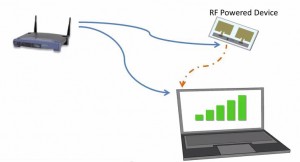Consider how convenient it would be for everyday battery-free devices to have similar functions to the Wi-Fi enabled shelf devices used regularly, like smartphones and laptops.

By powering battery-free devices with an embedded sensor that absorbs signals from the surrounding Wi-Fi infrastructure, passive devices are activated with a Low-WiFi “carrier wave” that allows them to communicate, track activity and store information without altering its hardware.
So, how do we connect battery-free devices to the internet using the surrounding Wi-Fi? With a Wi-Fi backscatter tag, of course. Wi-Fi Backscatter is a new technology developed by engineers at the University of Washington that embraces the approaching “Internet-of-things” reality with an innovative technology built into wearable objects with a battery-free sensor. The UW researchers built a battery free, ultra-low power tag prototype sensor with an antenna and circuitry that can consume the unused power from an existing Wi-Fi infrastructure and harnesses these low-powered radio-frequency signals in the sensors to connect everyday objects to the internet.
Though this Wi-Fi transmission-like technology is still in its development process and it faces many challenges, it could open the door to a new platform of IOT-adjacent technologies for everyday use. Currently, the UW Wi-Fi Backscatter tag can communicate with Wi-Fi devices at a 2-meter distance and at a rate of 1 kilobit per second. The plan is to patent this new technology and amplify its range to approximately 20 meters.
Photo Credit: https://youtu.be/snZWgAZqo2c – WiFi Backscatter: Connecting RF-Powered Devices to the Internet video. Watch the full video below.
Related Links:
By 2019, 60% of all mobile data traffic will be carried by Wi-Fi

